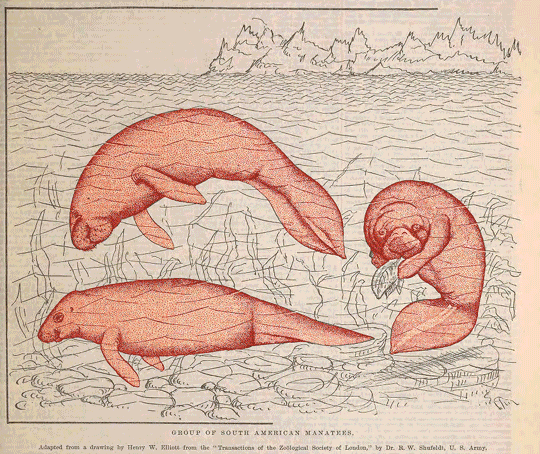Mermaid or Manatee?
C’mon, you really can’t tell the difference? You’ve been out to sea waaaay too long.

Group of South American Manatees from “Forest and Stream,” v. 29 (1887 – 1888)
Centuries ago manatees were mistaken for mermaids, the half-woman/half-fish creature of myth and legend. The confusion may seem absurd now, but back then little was known of the sea beasts that lived in the ocean (much of the ocean is still unexplored today).
The mystery of the unknown coupled with some of the manatee’s humanlike features—its ability to turn its head, the fingerlike bones in its forelimbs, its flat tail—possibly led sailors to mistake it for the mythical creature, especially from a distance.
The first recorded half-fish, half-human creature was in the fourth century B.C.: Oannes, a Babylonian god would leave the sea every day and return at night. Also, in Homer’s Odyssey, the sirens of ancient Greece who lured sailors to their deaths were often portrayed as mermaids. In many languages, the word “siren” means mermaid—and the scientific name for manatees and dugongs is Sirenia.
In 1493, Christopher Columbus recorded the first written account of manatees in North America:
“…when the Admiral went to the Rio del Oro [Haiti], he said he quite distinctly saw three mermaids, which rose well out of the sea; but they are not so beautiful as they are said to be, for their faces had some masculine traits.”
Today, manatees face many challenges. Because of their large size and slow pace, they are easily injured or killed when caught in fishing nets or when struck by motorboats; blooms of poisonous algae are another threat. The International Union for Conservation of Nature has listed all three species of manatees as either endangered or threatened.
This Smithsonian Libraries’ GIF was made from an image of the South American Manatees in Forest and Stream, v. 29 (1887–1888). It can be found can be found in its entirety in @biodivlibrary(source: biodiversitylibrary.org).
Read more about manatees at the Smithsonian’s National Museum of Natural History’s Ocean Portal.
Posted: 25 April 2019
- Categories:






